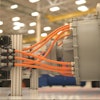This article first appeared in the September 2013 issue of Food Manufacturing.
A number of recent news stories have focused on glass contamination in leading global food processing facilities.
In one case, consumers discovered glass shards in their frozen dinners. Another incident involved the discovery of broken glass from a light bulb found in a dough production area, forcing a restaurant chain to close 40 locations until it verified the bread was indeed free of glass. One compay is a manufacturer of some of the most well known food and beverage brands in the world, and the other is a leading international fast food chain. There is no doubt this problem is one to be taken very seriously. The outcome of such findings has not only compromised the integrity of the organizations’ reputations, but has resulted in thousands of dollars in cleanup, unsalable product and loss of revenue.
Entities such as OSHA and the FDA have strict mandates requiring facilities to provide protective coverings for exposed glass within food processing areas. FDA code 110.20 Section B, Part 5 mandates that a facility must “provide safety-type light bulbs, fixtures, skylights or other glass suspended over exposed food in any step of preparation or otherwise protect against food contamination in case of glass breakage.”
Unfortunately, proper precautionary protection is not always executed or substandard protective mechanisms are installed and fail when they are needed most. Inevitably, another story of glass contamination in food products will hit the wire, production lines will be halted and the cleanup process executed.
The occurrence of glass from a broken light bulb contaminating food processing facilities is all too common. If a lamp is accidentally broken, the effects of glass shards, mercury and phosphor polluting food products, machinery, employee workstations or packaging and food storage areas can be detrimental. While tiny fragments of glass may go undetected by the human eye, the damage they can cause is imminent. The challenge of detection is amplified for frozen food processors, as glass shards could easily be mistaken for ice crystals in products. Also, with the extended shelf life of frozen food products, it may be more difficult to identify and recall tainted product once the contamination is identified. Regardless of whether the products are frozen or hot, dry or liquid, the consequences imposed by the presence of exposed glass within a facility can be both costly and dangerous.
There are preventative measures that can be taken to mitigate the risk of contamination from glass from light bulbs. While inspectors do check to ensure that safety lamps are being used, there is no specification set as to what type of protective measures must be utilized, allowing consideration of two options: tube guards or shatter-resistant light bulbs. Tube guards are the least expensive but have the highest probability of failure. End caps can easily pop off, leaving the glass exposed if the light bulb breaks. End caps can also interfere with the fluorescent tube pins fitting properly into fixtures, posing risk to the performance of the lamp as well as being a potential fire hazard. Tube guards allow hot air to be trapped between the lamp and the plastic sleeve, which in turn will melt the tube rendering it ineffective.
The risks associated with tube guards are so great that the National Emergency Management Agency (NEMA) has formally published a warning surrounding their use. The other option for protective lighting is having a safety coating applied directly to the lamp to make it shatter-resistant. This offers the advantages of being fully covered without having to worry about end caps posing problems, as well as reducing the air gap between the light bulb and the plastic sleeve. While this option tends to be more reliable than tube guards, it can still pose risks. Many manufacturers’ coatings are made of substandard material, which will degrade over time due to UV emissions from the lamp. UV emissions can cause the coating to yellow, crack and flake off, falling into food or packaging below and eventually leave the lamp unprotected.
Extrusion is a more reliable coating process than simply applying a plastic sleeve onto the lamp, powder spraying or hand dipping the lamp into its coating. In the extrusion method, heated plastic material blend is applied directly onto the lamp, which results in the coating being skin-tight from end to end leaving no gap to trap heat. With this method, virtually all glass, phosphors and mercury are safely contained within the clear and tough plastic coating if a lamp is accidentally broken, making the lamp just as safe the day it burns out as the day it was installed.























